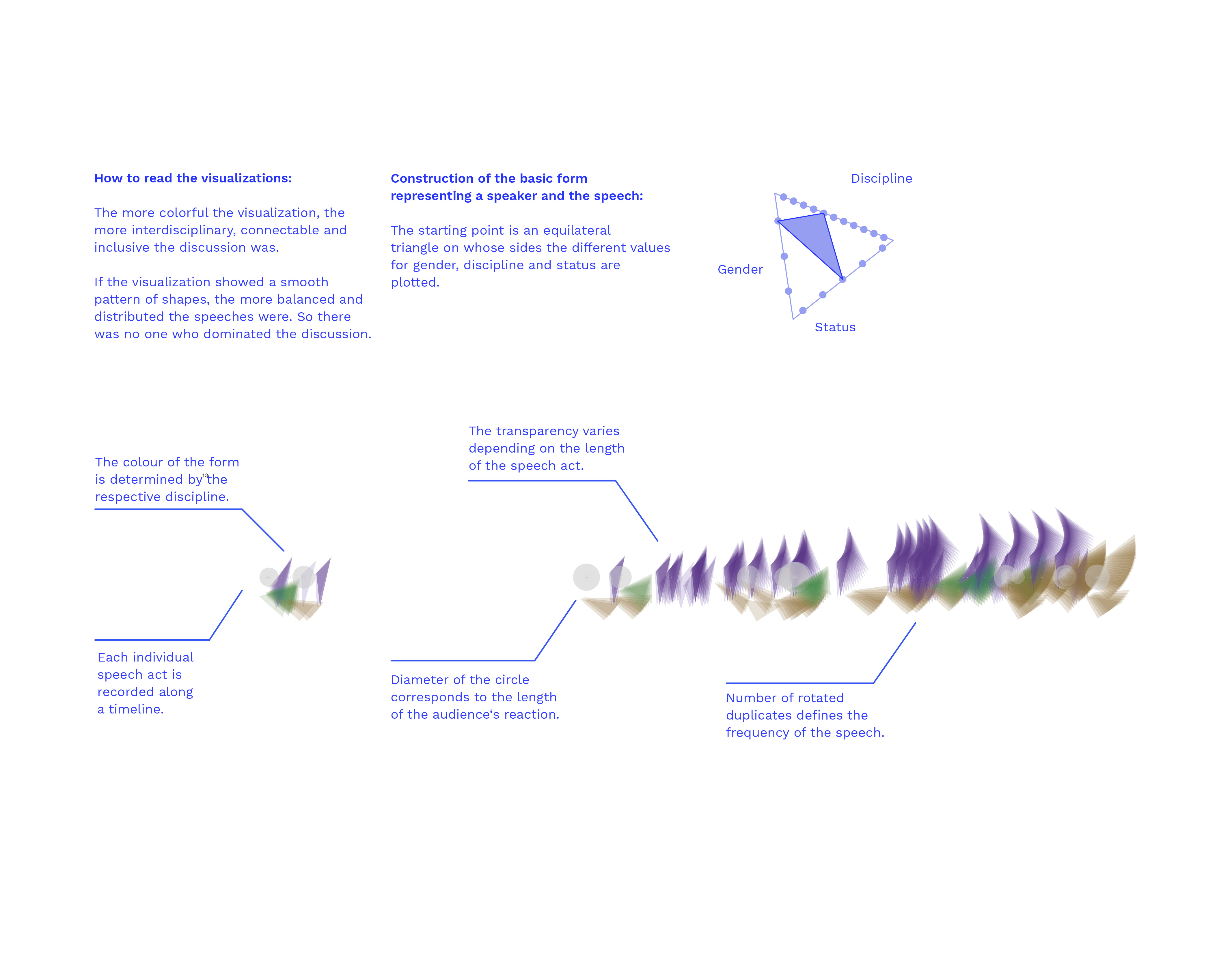
Visualizing Speeches
The aim of this project was to visualize the communication dynamic of a weekly event that was supposed to be a casual open interdisciplinary lecture and discussion without any strict academic formalities and disciplinary boundaries. But in reality the exact opposite was the case and everybody was upset about that fact.
Following this observation, my research group decided to show our colleagues on an abstraxct level what the dynamic really was like. Nobody was to be exposed. Rather, it was about stimulating a discussion that resulted in rules of communication that worked against this stiff and stressful discussion culture.
Visualizing Speeches
The aim of this project was to visualize the communication dynamic of a weekly event that was supposed to be a casual open interdisciplinary lecture and discussion without any strict academic formalities and disciplinary boundaries. But in reality the exact opposite was the case and everybody was upset about that fact.
Following this observation, my research group decided to show our colleagues on an abstraxct level what the dynamic really was like. Nobody was to be exposed. Rather, it was about stimulating a discussion that resulted in rules of communication that worked against this stiff and stressful discussion culture.




This version takes an equilateral triangle as a starting point for the representation of the recorded speaker characteristics (gender, discipline, status) and expresses the frequency and duration of the speech acts via rotation about its own axis and transparency of the surface. The visualization was created with Processing.
This version takes an equilateral triangle as a starting point for the representation of the recorded speaker characteristics (gender, discipline, status) and expresses the frequency and duration of the speech acts via rotation about its own axis and transparency of the surface. The visualization was created with Processing.
But using data visualization in order to communicate and to discuss with a small group that is actually the origin of this visualization is quite a challenge. You need to make sure that no one can ever draw any conclusions about who exactly is menat by this visualization. The protection of privacy in this internal communication is a big deal.
On this basis, I have developed a visualization concept that constructs forms or bodies from the recorded personal parameters, which are different from each other, but cannot be clearly assigned. In this way, the generated visualization concentrates only on the dynamics of the course of the discussion, i.e. the intensity of the participation of persons from different disciplinary backgrounds in the discussion.
But using data visualization in order to communicate and to discuss with a small group that is actually the origin of this visualization is quite a challenge. You need to make sure that no one can ever draw any conclusions about who exactly is menat by this visualization. The protection of privacy in this internal communication is a big deal.
On this basis, I have developed a visualization concept that constructs forms or bodies from the recorded personal parameters, which are different from each other, but cannot be clearly assigned. In this way, the generated visualization concentrates only on the dynamics of the course of the discussion, i.e. the intensity of the participation of persons from different disciplinary backgrounds in the discussion.




Three examples of different discussions presented with the use of constructed bodies. These visualizations were also interactive and could be fast-forwarded and fast-reversed with the help of a slider.
Three examples of different discussions presented with the use of constructed bodies. These visualizations were also interactive and could be fast-forwarded and fast-reversed with the help of a slider.
Anouk Hoffmeister: Design & Concept
Tom Brewe: Coding (Processing)
This concept was developed within the research group Experiment & Observation at the Cluster of Excellence Image Knowledge Gestaltung (Humboldt Universität zu Berlin, 2015).
Anouk Hoffmeister: Design & Concept
Tom Brewe: Coding (Processing)
This concept was developed within the research group Experiment & Observation at the Cluster of Excellence Image Knowledge Gestaltung (Humboldt Universität zu Berlin, 2015).